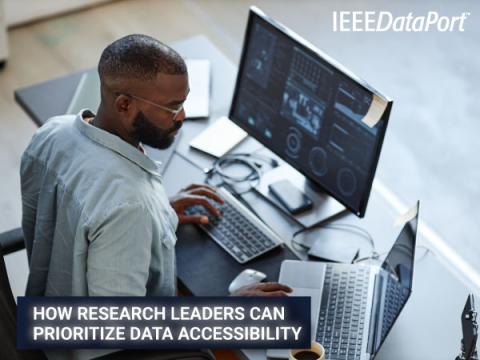Create your Data Management Plan with IEEE DataPort
When considering grant applications, one of the most important requirements funding agencies are looking for is the development and submission of a Data Management Plan (DMP). IEEE DataPort is currently piloting a feature that is available all all IEEE DataPort logged in users that makes it quick and easy to create a DMP that will meet the funding agency requirements. Users who create DMPs on IEEE DataPort can save their plan on the IEEE DataPort platform, download and save it locally on their desktop in PDF format, or can submit it electronically or physically as part of a research project proposal documentation.
This article provides additional information on what a Data Management Plan (DMP) is and how IEEE DataPort can help you succeed.
What is a Data Management Plan?
A DMP outlines how you will store, manage and make your data accessible over time. It also describes what data will be collected and produced from your research, as well as identifying any standards that will be used. DMP presentation formats can vary by funding agency and IEEE DataPort provides a reference to assist you with identifying the proper format. A typical DMP includes the following information:
- Project, Methodologies, and Data
In this section, you will describe the purpose of your research, how you will perform your research, what data you will collect, how you will collect the data, in what format the data will be collected, who will be managing the data. - Documentation, Organization, and Storage
Here, you will describe the format in which your data will be presented, what kind of files you will share, what metadata will be included, where your data will be permanently stored, how your data will be protected. - Access, Sharing, and Reuse
This will identify who will have access to your data, how they can access your data, who holds the rights to your data, whether your data can be reused (and by whom). - Archiving
In this section, you will address how the data will be preserved, how long it will be retained, where it will be archived.
How IEEE DataPort Can Help
In a new offering available to all IEEE DataPort logged in users during the pilot, IEEE DataPort will guide you through the process of creating a DMP, step-by-step, through a simple Web form. This form prompts you to provide required metadata and information about your research data, including author, licensing information, meta description, and research description. Additional details required for a DMP, such as how the data is stored and how it is made accessible to other researchers is automatically populated into the plan. Once you have completed the form, you can save the plan to update later or save it as a PDF for printing and sharing.
You can create the DMP through IEEE DataPort before you have conducted the research, as it is typically required to secure funding. If you are an individual user or your organization is an IEEE DataPort Premium Institutional Subscriber, all you need to do is create an account on IEEE DataPort or login to your existing account, click on “My Account,” and click the “Create DMP” button, and fill out the required form fields. Once your research is complete and you are ready to upload your dataset to IEEE DataPort, the information you have added to create the Data Management Plan (DMP) will transfer over to your dataset page, saving you time.
To learn more about how to create a DMP through IEEE DataPort, visit this support document article.
Ready to get started? Upload your research data to IEEE DataPort today or learn more about how your organization can become an IEEE DataPort Premium Institutional Subscriber.
- 5141 reads



